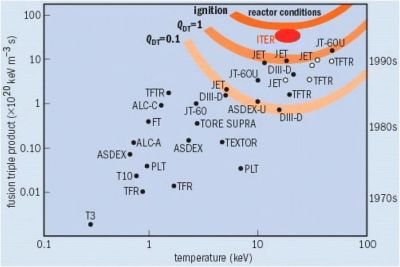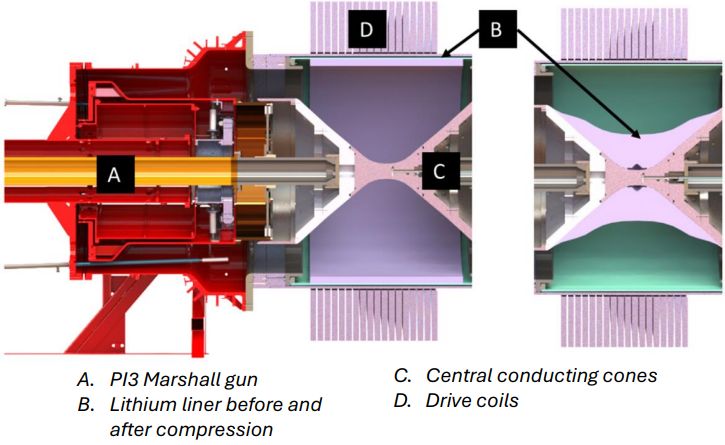It’s rarely appreciated just how much more complicated nuclear fusion is than nuclear fission. Whereas the latter involves a process that happens all around us without any human involvement, and where the main challenge is to keep the nuclear chain reaction within safe bounds, nuclear fusion means making atoms do something that goes against their very nature, outside of a star’s interior.
Fusing helium isotopes can be done on Earth fairly readily these days, but doing it in a way that’s repeatable — bombs don’t count — and in a way that makes economical sense is trickier. As covered previously, plasma stability is a problem with the popular approach of tokamak-based magnetic confinement fusion (MCF). Although this core problem has now been largely addressed, and stellarators are mostly unbothered by this particular problem, a Canadian start-up figures that they can do even better, in the form of a nuclear fusion reactors based around the principle of magnetized target fusion (MTF).
Although General Fusion’s piston-based fusion reactor has people mostly very confused, MTF is based on real physics and with GF’s current LM26 prototype having recently achieved first plasma, this seems like an excellent time to ask the question of what MTF is, and whether it can truly compete billion-dollar tokamak-based projects.
Squishing Plasma Toroids

In general, to achieve nuclear fusion, the target atoms have to be pushed past the Coulomb barrier, which is an electrostatic interaction that normally prevents atoms from approaching each other and even spontaneously fusing. In stars, the process of nucleosynthesis is enabled by the intense pressures due to the star’s mass, which overcomes this electrostatic force.
Replicating the nuclear fusion process requires a similar way to overcome the Coulomb barrier, but in lieu of even a small-sized star like our Sun, we need alternate means such as much higher temperatures, alternative ways to provide pressure and longer confinement times. The efficiency of each approach was originally captured in the Lawson criterion, which was developed by John D. Lawson in a (then classified) 1955 paper (PDF on Archive.org).
In order to achieve a self-sustaining fusion reaction, the energy losses should be less than the energy produced by the reaction. The break-even point here is expressed as having a Q (energy gain factor) of 1, where the added energy and losses within the fusion process are in balance. For sustained fusion with excess energy generation, the Q value should be higher than 1, typically around 5 for contemporary fuels and fusion technology.
In the slow march towards ignition, we have seen many reports in the popular media that turn out to be rather meaningless, such as the horrendous inefficiency demonstrated by the laser-based inertial confinement fusion (ICF) at the National Ignition Facility (NIF). This makes it rather fascinating that what General Fusion is attempting is closer to ICF, just without the lasers and artisan Hohlraum-based fuel pellets.
Instead they use a plasma injector, a type of plasma railgun called a Marshall gun, that produces hydrogen isotope plasma, which is subsequently contained in a magnetic field as a self-stable compact toroid. This toroid is then squished by a mechanical system in a matter of milliseconds, with the resulting compression induces fusion. Creating this toroid is the feat that was recently demonstrated in the current Lawson Machine 26 (LM26) prototype reactor with its first plasma in the target chamber.
Magneto-Inertial Fusion
Whereas magnetic confinement fusion does effectively what it says on the tin, magnetic target fusion is pretty much a hybrid of magnetic confinement fusion and the laser-based intertial confinement fusion. Because the magnetic containment is only there to essentially keep the plasma in a nice stable toroid, it doesn’t have nearly the same requirements as in a tokamak or stellarator. Yet rather than using complex and power-hungry lasers, MCF applies mechanical energy using an impulse driver — the liner — that rapidly compresses the low-density plasma toroid.

The juiciest parts of General Fusion’s experimental setup can be found in the Research Library on the GF website. The above graphic was copied from the LM26 poster (PDF), which provides a lot of in-depth information on the components of the device and its operation, as well as the experiments that informed its construction.
The next step will be to test the ring compressor that is designed to collapse the lithium liner around the plasma toroid, compressing it and achieving fusion.
Long Road Ahead

As promising this may sound, there is still a lot of work to do before MTF can be considered a viable option for commercial fusion. As summarized on the Wikipedia entry for General Fusion, the goal is to have a liquid liner rather than the solid lithium liner of LM26. This liquid lithium liner will both breed new tritium fuel from neutron exposure, as well as provide the liner that compresses the deuterium-tritium fuel.
This liquid liner would also provide cooling, linked with a heat exchanger or steam generator to generate electricity. Because the liquid liner would be infinitely renewable, it should allow for about 1 cycle per second. To keep the liquid liner in place on the inside of the sphere, it would need to be constantly spun, further complicating the design.
Although getting plasma in the reaction chamber where it can be squished by the ring compressor’s lithium liner is a major step, the real challenge will be in moving from a one-cycle-a-day MTF prototype to something that can integrate not only the aforementioned features, but also run one cycle per second, while being more economical to run than tokamaks, stellarators, or even regular nuclear fission plants, especially Gen IV fast neutron reactors.
That said, there is a strong argument to be made that MTF is significantly more practical for commercial power generation than ICF. And regardless, it is just really cool science and engineering.
Top image: General Fusion’s Lawson Machine 26. (Credit: General Fusion)
















“which is an electrostatic interaction that normally prevents atoms from approaching each other and even spontaneously fusing. In stars, the process of nucleosynthesis is enabled by the intense pressures due to the star’s mass, which overcomes this electrostatic force.”
Fun fact: it actually doesn’t. The pressure isn’t high enough for fusion to occur rapidly in stars – it only happens due to the long tail from quantum tunneling. The reason you get so much energy from it is because, well, in addition to the extreme pressure, there’s also extreme density (150x water, or around 15x lead) and so “lots of atoms” times “low probability” is still “big number.” Except it isn’t even that big a number – it’s only a huge amount of power because in addition to extreme pressure, extreme density, it’s also… just effing huge.
Volumetrically, the core of the Sun produces a pathetic amount of power. It’s like 300 W/cubic meter. We don’t need fusion reactors to have conditions like the core of a star. We need them to have conditions well beyond the core of a star.
My favorite way to put this into perspective: by volume a large pile of compost produces more heat than the sun. The square/cube law is amazing.
Somewhere it was stated that the energy density of the sun is roughly equivalent to that of a pile of mulch or a box turtle. That and your comment means that the fact we can do fusion on earth at all, let alone commercially viable etc is kind of impressive.
Power density, not energy density. The sun’s energy density is trillions of times greater than a pile of mulch, it’s just spread out over ten billion years.
Yup it’s hard for energy to flow (power) when the photons keep hitting dense superficial layers.
Looks like prison toilet on steroids. My uncle did time in Bulgaria in 1990s, the stories he told me… it sometimes comes back in dreams and makes me suffer from PTSD.
Bulgaria was building fusion reactors in the 1990’s?!?!
Yeah. In prisons too. Thems crazy commies :)
Out of poop 💩.
Couldn’t resist. Sorry.
What part of any of this looks like a toilet? Is this some meme or copypasta that’s flying over my head?
As it is using deuterium, tritium and helium 3 for fuel, elements that are made in fission reactors inplace of outputting electricity, then what would be the advantage over just making electricity in the fission reactor?
Well since they are in Canada deuterium and tritium wouldn’t be hard for them to get.
There is enough deuterium in seawater for tens of millions of years. Tritium can be made from lithium once the fusion reactor is running.
Headline:
WTF is MTF
Fusion does happen all around us with no human interaction. Just look up. They’re called stars, and they’re pretty simple, they just don’t scale down very well.
Sounds like someone created a Diesel engine for fusion.
Inject fuel. (plasma)
Contain and compress.
Combustion.
Exhaust waste products and repeat.
The one missing thing seems to be exhaust. The fused atoms from the previous cycle could well contaminate the injected plasma of the next cycle of the reactor.
But it is rather funny how closely it follows the 1880’s idea.
If the lithium is liquid, how can it compress against the gravity? I understand that if they spin the vessel it’ll accumulate on the external border by centrifugal force, but as soon as the vessel is stopped, it’ll just fall down so only half of it will compress the plasma, the lower part will simply stay where it is, right?
So I’m no expert here, but I think the process involves the magnetic field compressing the liquid “container”, which then compresses the contained plasma to initiate fusion.
I think they’re still planning to smack it with a big hammer. Not sure how they plan to do that, but surely the nuclear engineers have some ideas.
It doesn’t stop spinning. The liquid metal liner is compressed by gas pressure from the outside: there are pistons in both the rotor and outside – the outside pistons push against gas that the rotor’s spinning in, that pressure collapses the liner, which compresses the plasma. The outer pistons allow you to vary the pressure against the liner causing the collapse, which shapes the inner surface as well.
A description of the experiment they designed to demonstrate that you can do this is here:
https://www.sciencedirect.com/science/article/pii/S0920379623006671
General Fusion…
The company that though using piston and black powder (maybe it was some other explosive / chemical) would be the easiest way. Still took them a many years to understand that synchronizing many dozen of explosive on a nano second scale would be pretty hard…